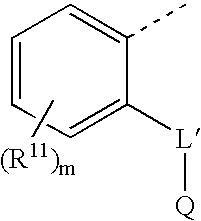Photographic material containing a novel hydrazine type
a technology of hydrazine and photographic material, which is applied in the direction of photosensitive materials, instruments, group 5/15 element organic compounds, etc., can solve the problems of limited development capacity, complicated replenishment systems, and inability to meet the needs of lith development, so as to improve the dimensional stability of photographic elements
- Summary
- Abstract
- Description
- Claims
- Application Information
AI Technical Summary
Benefits of technology
Problems solved by technology
Method used
Image
Examples
example 1
[0067] Preparation of the Emulsion
[0068] To an aqueous gelatin solution containing sodium chloride, an aqueous solution of silver nitrate and an aqueous halide solution containing ammonium bromide, sodium chloride, 2.3.times.10.sup.-7 mol / mol silver of Na.sub.3RhCl.sub.6 and 3.0.times.10.sup.-7 mol / mol silver of Na.sub.2IrCl.sub.6 were added with stirring in accordance with a double jet method to form silver chlorobromide grains having an average grain size of 0.27 .mu.m (variation coefficient: 19%) and a chloride content of 64 mol %.
[0069] Thereafter, the emulsion was washed using a conventional flocculation method, and then redispersed with 27 g / mol silver of gelatin. The resulting emulsion was adjusted to pH 5.0 and then chemically sensitized at 50.degree. C. by adding 3.9 mg / mol silver of chloroauric acid and 3.3 mg / mol silver of sodium thiosulfate and digesting during three hours. The emulsion was stabilized with 8.4.times.10.sup.-3 mol / mol silver of 4-hydroxy-6-methyl-1,3,3a,7...
example 2
[0081] Exposure and Photographic Processing
[0082] Each sample from example 1 was exposed to a xenon flash lamp (light emitting time: 10.sup.-5 s) through both a step wedge and a filter having its peak at 622 nm, and then developed for 30 seconds at 35.degree. C. with developer B. Thereafter, it was subjected successively to fixation in a conventional fixation bath, washing and drying operations. The processing took place in a Rapiline 66T3 processor.
5 Composition of developer B Water 750 ml Potassium hexametaphosphate 7.5 g. Potassium carbonate 48.2 g. Potassium sulfite 3.28 g. Sodium bromide 6.5 g. Potassium hydroxide 5.51 g. Na.sub.4-EDTA 2.1 g. Sodium erythorbate 43 g. Potassium metabisulfite 21 g. 4-Hydroxymethyl-4-methyl-1-phenyl- 1.0 g. 3-pyrazolidone Rhodafac RM 710 75 mg Phenylmercaptotetrazole 0.03 g. Compound A 0.035 g. Water to adjust the volume to 11
[0083] Compound A is represented by following formula: 17
[0084] Evaluation of Image Contrast
[0085] The samples were exposed...
PUM
| Property | Measurement | Unit |
|---|---|---|
| Fraction | aaaaa | aaaaa |
| Fraction | aaaaa | aaaaa |
| Fraction | aaaaa | aaaaa |
Abstract
Description
Claims
Application Information
 Login to View More
Login to View More - R&D
- Intellectual Property
- Life Sciences
- Materials
- Tech Scout
- Unparalleled Data Quality
- Higher Quality Content
- 60% Fewer Hallucinations
Browse by: Latest US Patents, China's latest patents, Technical Efficacy Thesaurus, Application Domain, Technology Topic, Popular Technical Reports.
© 2025 PatSnap. All rights reserved.Legal|Privacy policy|Modern Slavery Act Transparency Statement|Sitemap|About US| Contact US: help@patsnap.com



